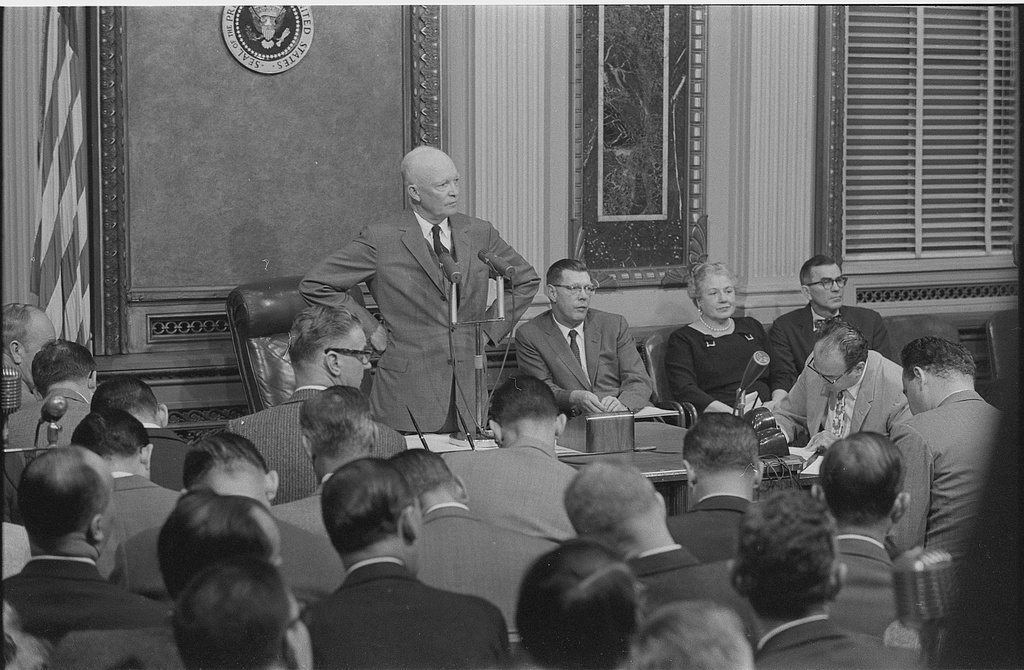Remembering Eisenhower’s Middle East Force Resolution
On this date in 1957, President Eisenhower signed into law perhaps the most open-ended force resolution in American history. It was never directly invoked, and it remains formally on the books to this day.
Eisenhower’s Request, Congress’s Response

Published by The Lawfare Institute
in Cooperation With

On this date in 1957, President Eisenhower signed into law perhaps the most open-ended force resolution in American history. It was never directly invoked, and it remains formally on the books to this day.
Eisenhower’s Request, Congress’s Response
In January, I wrote about an earlier congressional force resolution during the Eisenhower administration, related to what was then called Formosa, now called Taiwan. The Middle East resolution shared with the Formosa resolution many significant features: It was broad and open ended, it deliberately fudged constitutional issues in a way that became common for presidents thereafter, and it was primarily about signaling rather than warfighting. But unlike the Formosa resolution, which was whisked through Congress with almost unanimous support, the proposed Middle East resolution elicited several months of intense debate and was modified before Congress passed it.
As background, the Eisenhower administration saw the Middle East as an emergency situation in 1956. Following the Suez crisis, European allies’ influence there was discredited, and the administration feared that the Soviet Union would fill the vacuum without strong U.S. action and commitment.
In an address to Congress on Jan. 5, 1957, Eisenhower requested congressional support for a program of military and economic aid for Middle East nations, anticipating the possibility of communist aggression. He also sought authorization to use military force to protect such nations. The “Eisenhower Doctrine” would thus combine largesse with threats of armed intervention.
Two months later, Congress passed legislation that authorized the military and economic aid. As to the requested force authorization, Congress included the following provision:
[T]he United States regards as vital to the national interest and world peace the preservation of the independence and integrity of the nations of the Middle East. To this end, if the President determines the necessity thereof, the United States is prepared to use armed forces to assist any such nation or group of such nations requesting assistance against armed aggression from any country controlled by international communism.
Note that instead of “authorizing” force, the resolution declared a policy to use it. Some critics in Congress thought that this change dampened the delegation of power that the president requested, whereas the administration thought that the change had no effect. The resolution provided that it would expire when the president determined that the “peace and security of the nations in the general area of the Middle East” was “reasonably assured” or if Congress revoked it with a concurrent resolution.
To those (including me) who complain that Congress has not updated the 2001 authorization for use of military force, consider that Eisenhower’s Middle East force resolution is still law. Today it is 62 years old. And if the 2001 authorization seems exceptionally open ended, consider by comparison that Eisenhower’s “New Look” military policy emphasized imposing massive retaliatory damage with nuclear weapons and his 1957 resolution applied to an entire, vast and poorly defined region. When Eisenhower had previewed his proposed force resolution to congressional leaders a week before the vote, Sen. Richard Russell, the Democratic chairman of the armed services committee, worried that “if this step should be taken we would not want to let it appear that only a ‘small war’ might ensue.” Eisenhower responded that “should Russia move it could not possibly be a ‘small war.’”
Constitutional Debates and Uncertainty
As to the constitutional allocation of war powers, Eisenhower generally believed that major wars required legislative assent. Especially after watching the Korean War, waged without congressional authorization, nearly ruin President Truman before him, Eisenhower believed this as a matter of constitutional principle as well as political pragmatism and strategic necessity. President Eisenhower also believed that the president had power to launch smaller-scale military operations (or covert paramilitary ones) and that the president had significant emergency military powers. The lines between those presidential powers and Congress’s war powers were unclear, though.
Congress, in reviewing the proposed force resolution, was badly fractured on constitutional war powers questions. Some members supported the proposal, some thought it was preposterously (maybe unconstitutionally) open ended, and some thought it would set a dangerous precedent that (also maybe unconstitutionally) suggested the president lacked vital unilateral powers.
When defending the proposed resolution before the Senate, Secretary of State John Foster Dulles was pressed multiple times on whether the president already had ample constitutional power to protect militarily U.S. national interests in the Middle East. After noting that the constitutional allocation of war powers was unclear and contested, he stated Eisenhower’s position: that the president’s inherent authority to use force was limited and that, in light of constitutional ambiguity, a resolution would greatly strengthen his hand.
In one remarkable closed-door Senate foreign relations committee exchange on Jan. 2, 1957, Sen. Hubert Humphrey pushed Secretary Dulles on whether the resolution was needed:
Humphrey: Are we to understand or are we to interpret that in this area in the past, we would not have resisted Soviet aggression … [e]ven if American vital interests had been affected?
Dulles: That is the position that President Eisenhower takes. Now, I think President Eisenhower take a more conservative view of the power of the Executive than some other Presidents have taken; possibly because he himself comes into the office as a general, he feels the responsibility or the desire to share responsibility with the Congress more than perhaps a civilian President would. But the fact of the matter is that the President, I think, leans over backward in his unwillingness to use the Armed Forces of the United States in ways which Congress has not indicated it wants.
Humphrey: Yet he is asking us for predated declaration of war. … In other words, he is asking for a predate for the use of force, and takes a conservative point of view in the application of the Executive powers as Commander in Chief.
Dulles: That is quite right, except I do not like the phrase “predated declaration of war.”
The Senate committee report on the final 1957 resolution notes that members were sharply split as to the president’s and Congress’s respective powers. It went on to say that the resolution’s “language has the virtue of remaining silent on the question of the relationship between the Congress and the President with respect to the use of the Armed Forces for the objectives stated in the resolution.” The House committee report says essentially the same, that it’s better to paper over the issue than try to resolve the constitutional debate.
War Powers, Reassurance and Deterrence
I’ve previously highlighted my own interests in the president’s “Power to Threaten War” and how constitutional allocations relate to deterrence and coercive diplomacy. Eisenhower’s Formosa and Middle East resolutions fascinate me because the Eisenhower years combined expansive congressional force approvals with the absence of war, and because he seems to have thought more than perhaps any other previous president about constitutional processes and their effects on signaling.
In a four-hour White House meeting with congressional leadership on Jan. 1, 1957, the president emphasized that a force resolution would bolster deterrence and help reassure allies:
[Eisenhower] added that should there be a Soviet attack in that area he could see no alternative but that the United States move in immediately to stop it—other than suffering loss of that area to Russia. Loss of the area would be disastrous to Europe because of its oil requirements. He cited his belief that the United States must put the entire world on notice that we are ready to move instantly if necessary. He reaffirmed his regard for constitutional procedures but pointed out that modern war might be a matter of hours only.
The President believed that if the Administration had that kind of authority it might never have to be used.
In the Jan. 2, 1957, Senate foreign relations committee meeting, Dulles put it this way when asked why unilateral presidential commitments to protect Middle East partners from Soviet aggression was not sufficient:
[T]hese statements by the President act as a temporary shot in the arm, but these people are very sophisticated now. They know that unless Congress shares, in effect, in these declarations, they do not amount to very much, and cannot dependably make their plans in reliance upon them.
…You may say, “Why don’t we wait until the attack occurs?” Why, then it is too late. The whole purpose of this thing is to be a deterrent, a preventive to war.
Contrast this with the much more common use of congressional force resolutions today, to bless ongoing or already planned military interventions.
Legacy
Looking back at this as well as the Formosa case, I’m skeptical that foreign actors were as attuned to U.S. constitutional processes as Eisenhower believed. But since Eisenhower believed they were, he must have been concerned when his Middle East force authorization proposal did not fly through Congress unchallenged and without amendment like the Formosa resolution did.
As Arthur Schlesinger writes in “The Imperial Presidency,” the effect of Congress’s questioning and altering his proposed force authorization “was to convince him less of the need for serious consultation with Congress than of his inherent authority to employ armed forces at Presidential will.” The following year, when Eisenhower sent 14,000 troops to Lebanon, as a show of force to shore up its government, he didn’t even cite Congress’s Middle East resolution for authority.
Lebanon was the first and only time as president that Eisenhower sent combat troops into foreign territory (covert CIA paramilitary forces were another story). That Eisenhower withdrew those forces later that year after little violence is probably a big reason why Eisenhower is too little studied in histories of constitutional war powers. As I’ve noted before, “[s]cholars of constitutional war powers tend to look at actual wars, but if we want to understand how effectively they operate, we should be focusing at least as much on wars that didn’t happen.”
The Jan. 1, 1957, White House meeting about the Middle East force resolution may have been a post-World War II high-water mark in presidential deference to Congress on war powers (or some might say at least until President Obama decided to seek, momentarily and unsuccessfully, congressional authorization for strikes against Syria in 2013). After Eisenhower, credibility of American threats of force became predominantly associated with arguments for unilateral executive war powers.


.jpg?sfvrsn=5a43131e_9)


